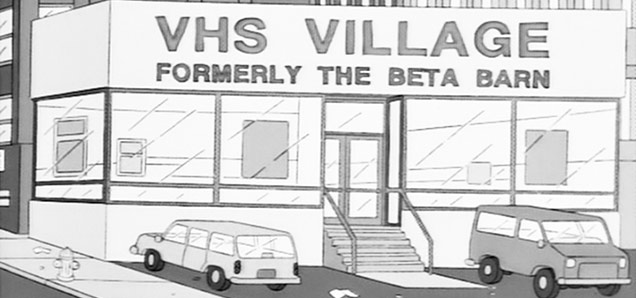Reel Life: Format wars! Battles waged, won and lost
 CREDIT: 20TH CENTURY FOX
CREDIT: 20TH CENTURY FOXBetamax at least lives on as a hilarious Simpsons joke.
It's a story as old as Tesla and Edison's AC-DC electric war; when there's a product in need of delivery, the fight between inventors trying to make their system the established method of delivering said product is inevitable. The 20th century ushered in a new kind of competition, the delivery of a much more ethereal product to the end user: movies.
With the advances of technology, the looming possibility of giving people at home a chance to watch and keep their favourite movies gave way to the rising Format Wars.
On Tape: Betamax vs. VHS
The most infamous and fiercely fought format war has to be Betamax vs. VHS. Although no more than the butt-end of in-jokes among tech history aficionados, don't mistake just how important this battle of home video products was. Largely born out of its predecessor, the TV-studio-based UMatic tape system, Sony's Betamax was the first home video format to be given a wide release, in 1975. Sony's peculiar obsession, one that carries to this day, with keeping their formats as closed off and exclusive to themselves was probably the first foot in the grave for the Betamax. Their refusal to license the technology to manufacture players and tapes to other companies is mainly what led to JVC's creation of the VHS. And from there of course, the rest is history. Starting straight out, VHS was ideal for the average consumer's home recording format, holding 215 minutes of video, far more than Beta's 60 minutes. The competition was indeed cutthroat, with Sony and JVC constantly releasing revisions and improvements to their formats. However, in the end, as we all know, VHS came out king, with cost largely being the factor. VHS's licensing out to other manufacturers ensured that anything related to the product would be naturally cheaper than the Sony in-house-made Beta. Cheap and more versatile? A natural winner, really. It isn't all doom and gloom for Beta, however. It still lives on as the standard for TV studio taping.
Of course, there was the Hollywood vs. videotape manufacturers' lawsuits, but that's a whole other story...
The Two Discs: Laserdisc vs. CED
The Laserdiscs's appearance of a comically oversized CD truly makes it the product of the early adoption of the disc-based format. Laserdiscs are sought after today as a collector's item, and mainly because those gigantic laserdisc covers with the movie poser emblazoned on it looks, well, hella sweet sticky-tacked on your bedroom wall like a makeshift poster. While not a direct competitor, the Capacitance Electronic Disc (CED) gets a mention here, out of benefit of also being disc-based, as well as having the most unusual appearance for any home video format, one that hasn't been mimicked since. The simplest way to describe the CED would be imagining your vinyl LPs (don't lie, you own some) having highly compacted grooves that were capable of holding video. Although introduced as the cheaper competitor to the VHS, the CED failed due to being, well, crap. CEDs themselves wore out faster than VHS tapes did, and any kind of dust or minor interference meant the death of the movie's watchability. Laserdisc, on the other hand, lived a fuller life. Mostly aimed at the high-end movie collector's market in North America, Laserdisc's superior image quality but high equipment cost ultimately made it a niche product, which also birthed the Criterion Collection. If you want a peek at a real-life CED disc, a trip to one of Toronto's many vintage stores will have to be in order.
The Future: Blu-ray vs. Digital Distribution
I've literally laid on a couch all day watching Netflix. Video on demand seems to be the way of the future for many, but it won't necessarily spell the death of the still-not- default Blu-ray. It's nice to physically hold your movie, and watch those awesome special features in non-stuttering 1080p after all.













